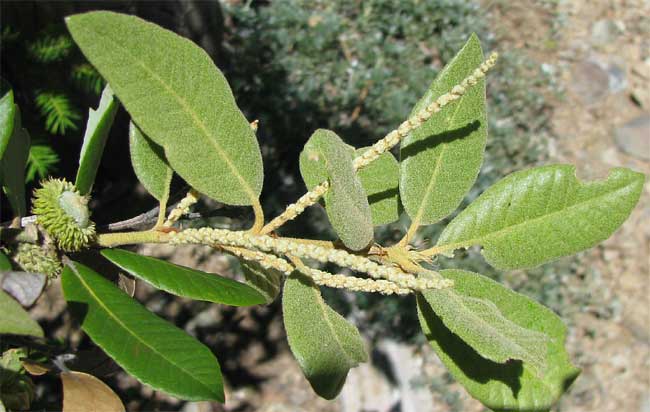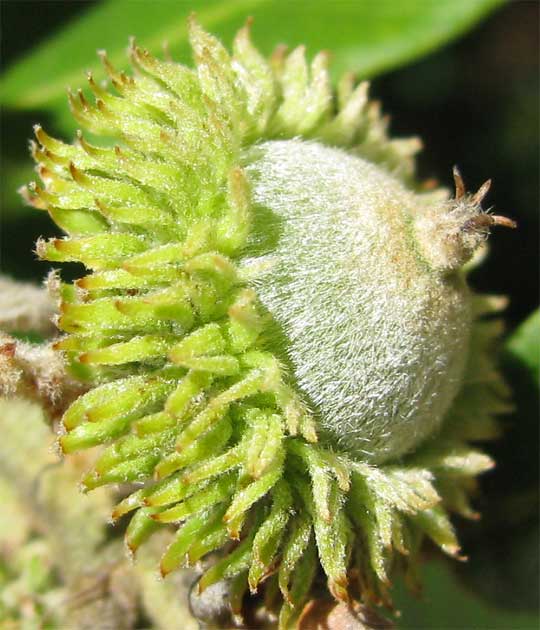
Excerpts from Jim Conrad's
Naturalist Newsletter
from the June 19, 2005 Newsletter issued from the Sierra Nevada foothills
somewhat east of Placerville, California, USA
TANOAKS, NOT OAKS

Once you're familiar with a few oak species you start thinking that oaks with their unique-looking acorns and many-scaled buds clustered toward twig tips are so distinctive that you'd never confuse an oak with anything else. Well, during this week's hike I found a little valley full of trees that definitely were bearing acorns, but there was something about the trees that was unsettlingly un- oakish. Most obvious, their abundant clusters of male flowers -- their catkins -- were stiff and often stood erect instead of weakly dangling as with every other oak I've seen. Also, the leaves looked like something between a chestnut leaf and a succulent eucalyptus leaf.
All oaks are members of the genus Quercus. The erect-catkined, acorn-bearing species I found in the valley was a member of the genus Lithocarpus. It was the Tanoak, LITHOCARPUS DENSIFLORA, and though it wasn't a "real oak" itself, it was a member of the Oak Family, along with oaks, beech and chestnuts. While there doesn't seem to be any single feature keeping Lithocarpus from being lumped into Quercus, there are too many minor differences between tanoaks and "real oaks" -- such as the tanoak's perky, stiff catkins -- for specialists to admit them into the oak genus. That's our Tanoak at the top of this page.
Tanoaks can be regarded as representing an evolutionary transitional stage between chestnuts and oaks -- they're missing links that aren't missing. Tanoak acorns certainly look transitional. The typical oak acorn consists of a nut arising from a cup composed of tiny, triangular, overlapping scales, while a chestnut fruit consists of nuts surrounded by a spiny husk. Tanoak acorns arise from cups the way oak acorns do, but the scales end in long, slender tips that flair outward, approximating the chestnut's spines, as shown below:

About 300 tanoak species exist, but all except ours live in Southeast Asia, Indonesia, and southern Japan. Our tanoak is limited to the Pacific coast from southwestern Oregon to central California, with a few isolated populations in our area.
America's tanoak has a history of ups and downs. Originally in our area fires occurred much more frequently than now and that restricted tanoaks to fairly small numbers. Today's lack of fires give tanoaks an advantage over other species, and in many fire-free areas tanoaks are now often quite numerous -- as in the little valley I discovered during my walk.
But now there's something new in the equation. In 1995 in southern California, Sudden Oak Death disease, caused by a fungus-like organism (a water mold) was discovered, and now that disease has become the main cause of tanoak death. The disease can wipe out a healthy population in a year's time. So far Sudden Oak Death is staying in coastal counties but if it ever takes hold here it'll have little difficulty spreading from tree-to-tree wherever trees grow close together -- as they do in the little fire-protected cove I found them in near here.